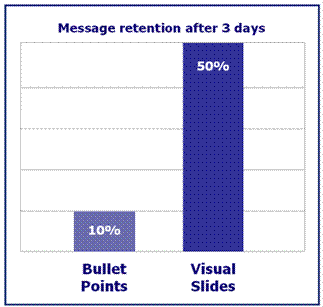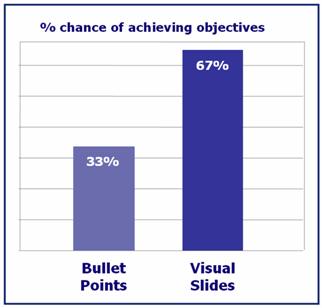
|
|
|
|
The 3 Things You Must Know Here we expose the three essential pieces of information that can make your presentation fly. Most of these are common sense, but you'd be surprised how often they are missed out.
OK? Want to know more? Here are a few lessons that will take you through the whole process. Click below.
I need more presentation ideas right away. Send me! CLICK HERE Use visual aids in your next presentation. Why? 1. How we take in information during a presentation
A lot of research has been carried out about how we take in information during a presentation. Current research concludes that 55% of the information we take in is visual and only 7% is text.
2. Making the presentation memorable
The old adage that "a picture is worth a thousand words" is indeed true after all. A study at Wharton University showed that using visual slides has a dramatic effect on message retention. The effect of using visuals is truly staggering. 3. Achieving your objectives
This study showed that by using visuals in your presentation you could expect roughly to double the chance of achieving your objectives. And if you are trying to make a sales presentation, this piece of advice could have a major impact on your bottom line. The conclusion: Use visual aids So hopefully by now you have got the message loud and clear. Use visual aids in your next presentation. 1. Presentation is a Learned Skill Many executives have unrealistic expectations about their speaking ability, believing that they can achieve proficiency without much effort. This attitude leads to significant frustration when their lax efforts fail to produce the desired results. People generally believe that if they can run a 100 million ringgit company, then they ought to be able to give a twenty minute speech without being fearful. That may not be true. I address the fear and frustration issues by asking executives, "How many times do you give major presentations each year?" It is usually a small number -perhaps five times. Then I ask, "How often do you make major decisions at the company?" "Practically every day, of course" is the common answer. I respond, "So why do you expect your speaking skills to be as developed as your decision-making ability? You simply do not speak enough to have overcome those fears of public speaking." Once an executive accepts the fact that it takes time to develop his or her speaking skills, the pressure is off to become a "perfect" speaker. When such a small amount of time is devoted to public speaking, one cannot expect to excel without some coaching and a little practice. Effectiveness is always a reasonable goal even with those executives who don't speak often. But perfection is unrealistic, and impossible. 2. Take Action: Rehearse and then Rehearse Again Once you accept the fact that making effective presentations is a learned skill, taking the time to rehearse is a natural step. Rehearsing your presentation over and over again will greatly reduce anxiety. "The single most important thing you can do for sweaty palms is rehearse. The second most important thing you can do for sweaty palms is rehearse. Guess what the third thing is?" The more familiar you become with your material, the more the words flow from you credibly and passionately. The more comfortable you feel with your words, the more naturally you present your speech. That's why good speakers practice - and practice again. Videotape - Nothing will improve your presentation more than seeing yourself on videotape. You will 3. Passion Eliminates Fear 4. "The Presentation" Try this: pause for a few seconds and "take in" your audience. Establish eye contact with them. Breathe deeply, smile, and allow yourself to relax for a moment. Now you are ready to begin! 5. What's the Worst that Could Happen? I want my people to be trained in a customized Train-the-Trainer Master Class. CLICK HERE The rule of three is one of the oldest in the book - Aristotle wrote about it in his book, ‘Rhetoric’. Put simply, it is that people tend to easily remember three things. Remember as a kid when your mum sent you down to the shop to buy a number of things. But when you got to the shop all you could remember were three things. This is the rule of three.
1. The audience will likely remember only three things from your presentation - plan in advance what will these be 2. There are three parts to your presentation 3. Use lists of three wherever you can in your presentation
A classic example of the rule of three was Winston Churchill's famous Blood, Sweat and Tears speech. He is widely attributed as saying I can promise you nothing but blood sweat and tears. What he actually said was "I can promise you Blood, Sweat, Toil and Tears" Because of the rule of three we simply remember it as Blood, Sweat and Tears. 4. In Presentations "Less is More" Concluding: Presentation Essentials
So there you have the presentation essentials. I suggest that you print out this little box and stick in somewhere where you can remember. Still unsure? CLICK HERE FAQs/Contact Us/Motivational & Inspirational Quotes/Useful Sites |




 notice mannerisms about yourself that you never noticed before. And you will instantly begin to make changes Audiotape - Listening to yourself on audio tape is another tool to use when you rehearse your presentations. Immediately, you'll know if you are speaking too quickly, too slowly, or if some words are difficult to understand. You will hear mistakes in grammar and inappropriate "um's" and "ah's" that are quite easily removed from your presentation when you are aware of them. The audio sessions will also help you zero in on content and vocal skills.
notice mannerisms about yourself that you never noticed before. And you will instantly begin to make changes Audiotape - Listening to yourself on audio tape is another tool to use when you rehearse your presentations. Immediately, you'll know if you are speaking too quickly, too slowly, or if some words are difficult to understand. You will hear mistakes in grammar and inappropriate "um's" and "ah's" that are quite easily removed from your presentation when you are aware of them. The audio sessions will also help you zero in on content and vocal skills.